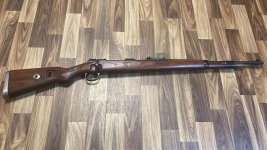Hello from good old germany!
I own a few handguns and just bought my first rifle. I initially thought this one would become a shooter for some time for me and then I seel it again (paid 500 EUR bucks). But then I got excited by the K98k history started to dig a bit deeper. I found it interesting / funny that I bought (unknowingly) a "true german version" of that rifle family. Honestly, I was just looking for any kind of K98 at that time.
Much respect to this forum here by the way, lots of skilled people! I find e.g. the blueprints and the numbering section very helpful. I alread read many threads and start to fear that this grows into some kind of addiction if I keep moving at this speed...
Also a couple of "brother rifles" out here so I hope you can help me with some questions on my rifle's "identity crisis"...
Here is - what I think - I know so far - please correct me if I'm wrong:
- Gustloff Werke, assembled in '43
- serial number 1870bb - at least for a certain fraction of it
- Russian capture
- re-activated by Frankonia München in 5KF - may 2016
- nice sophisticated way of hand engraved serial numbering on the "loader" (Verschluß - please excuse missing vocabulary in terms of rifles!)
Here is what I would like to know:
- Do you think the 1870 on the stock is original?
- What is this strange numbering on the barrel? Is it simply a different serial number (ch 3H7810) or is it another reference?
- I understood the Gustloff plant in Weimar was a large assembler, not a big manufacturer and they got supplier parts from lots of different locations. Is it "ok" in that sense for this Karabiner that the bajonett hook is not blued?
- Is this rifle missing a "Kornschutz"? So the protector around the forward aiming point?
- Is the forward band the correct one or should it be the "H-shaped" one?
- Is a red extractor probably ok for Gustloff rifles?
- Last one: the cleaning rod does surely have its hole in the bajonett hook, but the stock doesnt have the acutal hole in it to accomodate the rod. Nevertheless, I read somewhere that the rods where anyway not used so much during the late war time any more and the Wehrmacht decided to provide something like a bore snake for cleaning to the soliders. So since my rifle is from '43, it might have already been manufactured with a "cost and time saving change" to not drill this hole anymore into the stock. Does that make sense or is my stock fake in the sense of being a replica?
THANK YOU for helping me to get some orientation!
Cheers,
Rülpsilon
I own a few handguns and just bought my first rifle. I initially thought this one would become a shooter for some time for me and then I seel it again (paid 500 EUR bucks). But then I got excited by the K98k history started to dig a bit deeper. I found it interesting / funny that I bought (unknowingly) a "true german version" of that rifle family. Honestly, I was just looking for any kind of K98 at that time.
Much respect to this forum here by the way, lots of skilled people! I find e.g. the blueprints and the numbering section very helpful. I alread read many threads and start to fear that this grows into some kind of addiction if I keep moving at this speed...
Also a couple of "brother rifles" out here so I hope you can help me with some questions on my rifle's "identity crisis"...
Here is - what I think - I know so far - please correct me if I'm wrong:
- Gustloff Werke, assembled in '43
- serial number 1870bb - at least for a certain fraction of it
- Russian capture
- re-activated by Frankonia München in 5KF - may 2016
- nice sophisticated way of hand engraved serial numbering on the "loader" (Verschluß - please excuse missing vocabulary in terms of rifles!)
Here is what I would like to know:
- Do you think the 1870 on the stock is original?
- What is this strange numbering on the barrel? Is it simply a different serial number (ch 3H7810) or is it another reference?
- I understood the Gustloff plant in Weimar was a large assembler, not a big manufacturer and they got supplier parts from lots of different locations. Is it "ok" in that sense for this Karabiner that the bajonett hook is not blued?
- Is this rifle missing a "Kornschutz"? So the protector around the forward aiming point?
- Is the forward band the correct one or should it be the "H-shaped" one?
- Is a red extractor probably ok for Gustloff rifles?
- Last one: the cleaning rod does surely have its hole in the bajonett hook, but the stock doesnt have the acutal hole in it to accomodate the rod. Nevertheless, I read somewhere that the rods where anyway not used so much during the late war time any more and the Wehrmacht decided to provide something like a bore snake for cleaning to the soliders. So since my rifle is from '43, it might have already been manufactured with a "cost and time saving change" to not drill this hole anymore into the stock. Does that make sense or is my stock fake in the sense of being a replica?
THANK YOU for helping me to get some orientation!
Cheers,
Rülpsilon
Attachments
-
 01.JPG107.6 KB · Views: 46
01.JPG107.6 KB · Views: 46 -
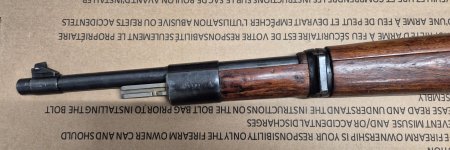 04.JPG227 KB · Views: 47
04.JPG227 KB · Views: 47 -
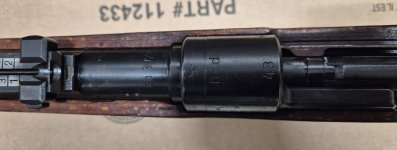 05.JPG124.4 KB · Views: 48
05.JPG124.4 KB · Views: 48 -
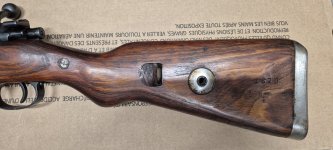 06.JPG255.9 KB · Views: 47
06.JPG255.9 KB · Views: 47 -
 IMG_5417.JPG144.6 KB · Views: 47
IMG_5417.JPG144.6 KB · Views: 47 -
 IMG_5420.JPG114.1 KB · Views: 40
IMG_5420.JPG114.1 KB · Views: 40 -
 LHRQ6558.JPG186.4 KB · Views: 37
LHRQ6558.JPG186.4 KB · Views: 37 -
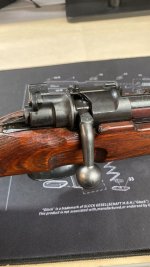 PRXM1664.JPG225.2 KB · Views: 32
PRXM1664.JPG225.2 KB · Views: 32 -
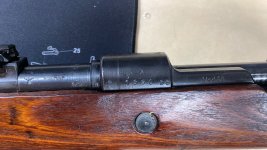 02a.JPG293.6 KB · Views: 33
02a.JPG293.6 KB · Views: 33 -
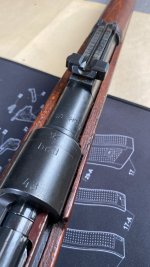 03a.JPG218.8 KB · Views: 36
03a.JPG218.8 KB · Views: 36 -
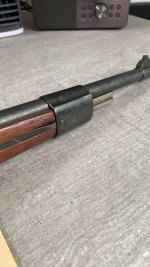 QJOT8714a.JPG296.9 KB · Views: 34
QJOT8714a.JPG296.9 KB · Views: 34 -
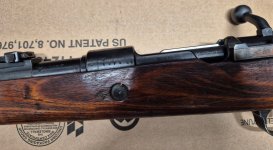 07a.JPG274.1 KB · Views: 47
07a.JPG274.1 KB · Views: 47


